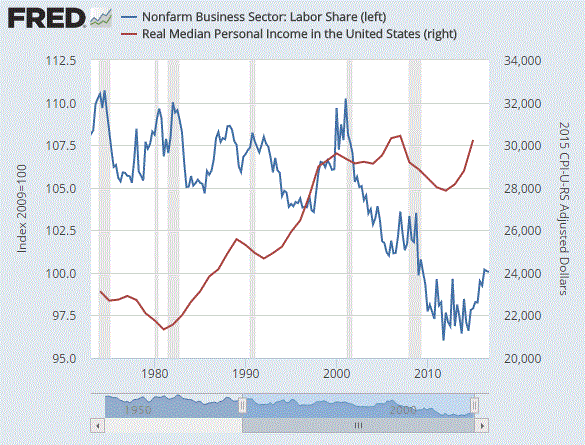Under the category of astonishingly boring papers with very large implications, consider the most recent paper from the Cleveland Fed.
I think most are familiar with some sort of version of this graph.

This graph uses median personal income (there is a complicated discussion around whether changes in household size create an anomaly.) The story it tells is well known, wages have stagnated as workers get less of share of what is produced. Of course the flip size is that capital owners get more of a share. Since 1999 about 6% more off all of what is produced (the index is used, not the actual share for reasons only the BLS knows).
This may not sound like much until you remember:
- 6% of total GDP is HUNDREDS OF BILLIONS
- Capital ownership is highly concentrated
This is why the rich are getting richer.
So the Cleveland Fed notes:
This change in the labor share may suggest that companies are replacing workers who perform routine jobs by automating or offshoring those jobs (Acemoglu and Autor 2011). By displacing a portion of a firm’s labor force, the automation process reduces the firm’s total wage costs and consequently the share of the total output that goes to labor. Moreover, the threat of further automation reduces workers’ bargaining power, depressing wage growth. Finally, the replacement process tends to occur at the middle of the wage distribution, inducing not only an increase in wage inequality, but also usually depressing average wages, as the number of workers negatively affected by automation (mid-skill workers) is significantly larger than the number of workers who may benefit from it (high-skill workers). A similar argument can be made for the offshoring process.
Translation: Machines and offshoring are taken jobs away from US workers, reducing their wages and making corporations richer.
Except: The Cleveland Fed concentrates on one part of the graph from above:

The Cleveland Fed again:
In terms of the timing of this substitution of capital for labor in the business cycle, Jaimovich and Siu (2015) show that the process is concentrated around recessions and jobless recoveries. Their explanation is supported by Sprague (2014)’s observation that hours dropped significantly more than output during the Great Recession. In addition, output recovered at a much faster pace than hours after the end of the Great Recession, generating rapid productivity growth in 2009 through 2010. By contrast, the later period of low productivity growth (2011 on) is one in which we observe output and hours moving in lockstep. This pattern suggests that the replacement of workers through automation may have run its course, with current job growth being concentrated in areas in which automation is not economically profitable (jobs that demand either abstract or hard-to-automate manual skills).
Translation: the cost of automating jobs is is about expensive as paying a person to do the job.
What the Cleveland Fed is saying is productivity growth from automation is slowing, as a result labor’s share of income has stabilized and is even growing.
One reads all sorts of papers about the coming robots are going to take everyone’s job apocalypse. But the relationship of technology and labor is not static. Machine can be labor replacing, but they can also be labor augmenting. In the later case machines make labor more valuable. When that happens (see the early days of the internet in the 90’s for example) labor’s share of income rises, and wages grow, sometimes dramatically.
It was an interesting paper: it runs counter to what the business press is full of.




